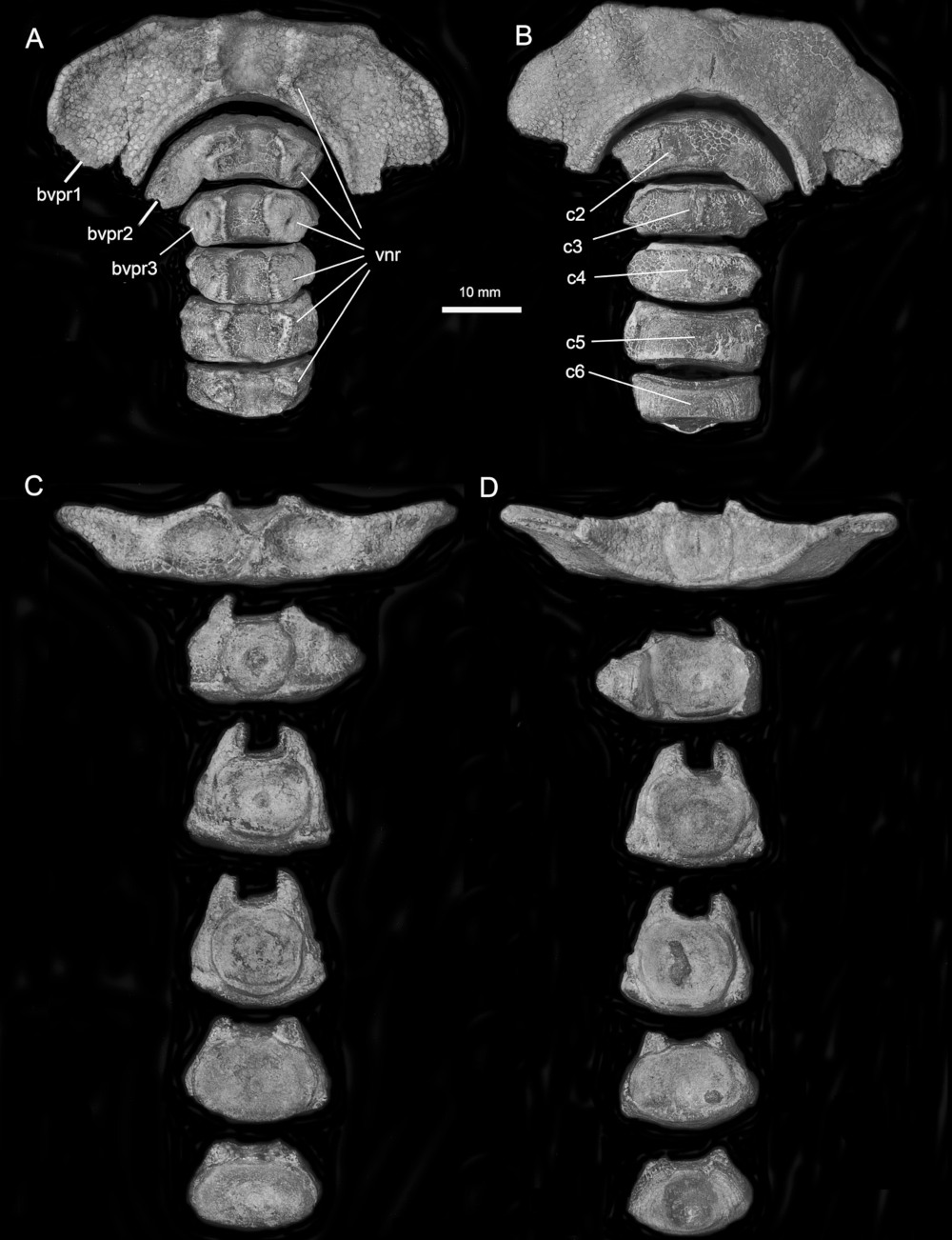Cretasquatina americana
Maisey, Ehret & Denton, 2020
Classification: Elasmobranchii Squatiniformes Squatinidae
Reference of the original description
A New Genus of Late Cretaceous Angel Shark (Elasmobranchii; Squatinidae), with Comments on Squatinid Phylogeny. American Museum Novitates, 3954, 1–29
A New Genus of Late Cretaceous Angel Shark (Elasmobranchii; Squatinidae), with Comments on Squatinid Phylogeny. American Museum Novitates, 3954, 1–29
Description:
Citation: Cretasquatina americana Maisey, Ehret & Denton, 2020: In: Database of fossil elasmobranch teeth www.shark-references.com, World Wide Web electronic publication, Version 12/2025
Please send your images of "Cretasquatina americana" to info@shark-references.com

Cretasquatina americana gen. nov., sp. nov. Holotype, ALMNH 2792-C, six associated vertebrae forming the anterior vertebral complex: A, dorsal view; B, ventral view; C, anterior views of centra 1–6; D, posterior views of centra 1–6. © Maisey et al. (2020)

Cretasquatina americana gen. nov., sp. nov. Holotype, ALMNH 2792-C, six associated vertebrae forming the anterior vertebral complex: A, dorsal view; B, ventral view; C, anterior views of centra 1–6; D, posterior views of centra 1–6. © Maisey et al. (2020)
Description
Original diagnosis after Maisey et al. (2020) p. 6 [28570]: Squatinid elasmobranch in which only the anteriormost two basiventrals of the vertebrae are expanded laterally. First basiventral process much broader distally than proximally, with rounded distal extremities and strongly recurved posterior borders surrounding the second basiventral and almost reaching the third centrum. Second basiventral process sharply angled posterolaterally, straight sided and slightly tapered distally. First vertebra with a vestigial anterior vertebral spool completely enclosed by the first basiventrals, notochordal canal does not reach anterior surface of first basiventral cartilage. Vertebral centra increase in width to centrum 5, then decrease in width. Palatoquadrate orbital process with smoothly rounded apex formed in tessellated cartilage and with a slight anterior projection on its anterolateral surface. Jaws smaller relative to the size of the occipital region than in other squatinids. Teeth unknown.
Original diagnosis after Maisey et al. (2020) p. 6 [28570]: Squatinid elasmobranch in which only the anteriormost two basiventrals of the vertebrae are expanded laterally. First basiventral process much broader distally than proximally, with rounded distal extremities and strongly recurved posterior borders surrounding the second basiventral and almost reaching the third centrum. Second basiventral process sharply angled posterolaterally, straight sided and slightly tapered distally. First vertebra with a vestigial anterior vertebral spool completely enclosed by the first basiventrals, notochordal canal does not reach anterior surface of first basiventral cartilage. Vertebral centra increase in width to centrum 5, then decrease in width. Palatoquadrate orbital process with smoothly rounded apex formed in tessellated cartilage and with a slight anterior projection on its anterolateral surface. Jaws smaller relative to the size of the occipital region than in other squatinids. Teeth unknown.
Remarks
shark-references Species-ID=15965;
type species of Cretasquatina Maisey et al., 2020 p. 285 [28570] by original designation (Art. 68.2 ICZN);
valid after Maisey et al. (2020) p. 6 [28570];
shark-references Species-ID=15965;
type species of Cretasquatina Maisey et al., 2020 p. 285 [28570] by original designation (Art. 68.2 ICZN);
valid after Maisey et al. (2020) p. 6 [28570];
References

Global impact and selectivity of the Cretaceous-Paleogene mass extinction among sharks, skates, and rays. Science, 379, 802–806
DOI: 10.1126/science.abn2080
A New Genus of Late Cretaceous Angel Shark (Elasmobranchii; Squatinidae), with Comments on Squatinid Phylogeny. American Museum Novitates, 3954, 1–29
DOI: 10.1206/3954.1

Global impact and selectivity of the Cretaceous-Paleogene mass extinction among sharks, skates, and rays. Science, 379, 802–806
DOI: 10.1126/science.abn2080
A New Genus of Late Cretaceous Angel Shark (Elasmobranchii; Squatinidae), with Comments on Squatinid Phylogeny. American Museum Novitates, 3954, 1–29
DOI: 10.1206/3954.1


















